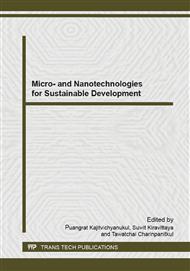p.77
p.85
p.91
p.97
p.105
p.113
p.121
p.129
p.137
Effects of Nickel on Properties of Cement Mortar Derived from the Co-Burning of Industrial Waste and its Leaching Behavior
Abstract:
Burning of hazardous waste in cement kiln is the new technology based on waste derived and alternative fuels. Besides being the alternative way to destroy hazardous waste, this method provides alternative material as raw material or the fuel in the cement production process. This disposal method can be applied if the contaminant either does not appear in the emission or leach from cement to environment. This work focused on properties and the leaching behavior of nickel from cement. The resulting clinker was analyzed for the content of free lime and X-ray diffraction (XRD) analysis was done. The identification of MgNiO2 peaks in XRD pattern was found in all clinkers with nickel addition in the range of 0.5-2.0 wt.%. Results obtained from this part suggested that nickel incorporated in the clinker phase and may combine with magnesium to form the new compound as MgNiO2 during the burning process. To study the leaching behavior, M3051A, NEN:7341 and pH static leach test were used. Results showed that approximately 3% of nickel can be leached to environment. From the pH static leach test, nickel was effectively leached at pH 4 and the reachability of its decreased when the pH increased. In this work, Toxicity characteristic leaching procedure (TCLP) was also used to identify the cement as hazardous waste or non-hazardous waste. The results showed that raw material doped with nickel up to 2 wt.%, the cement was not classified as hazardous waste.
Info:
Periodical:
Pages:
121-127
Citation:
Online since:
May 2015
Keywords:
Price:
Сopyright:
© 2015 Trans Tech Publications Ltd. All Rights Reserved
Share:
Citation:


